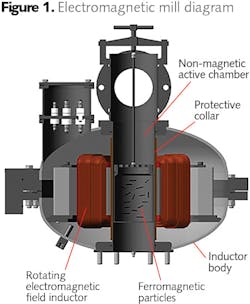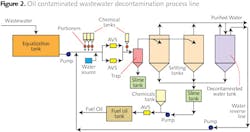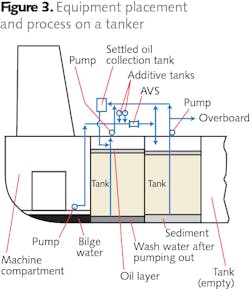By Frank May
Wastewater contaminated with oil is one of the most difficult wastes to decontaminate. The sludge is particularly challenging: besides oil, it contains metal particles, sand and other impurities, both solid and liquid. The goal of this article is to demonstrate the ability of a Vortex Layer Device to solve the problem of petroleum-contaminated water treatment directly on vessels, such as oil tankers.
All data collected was analyzed in order to design a compact, onboard wastewater treatment system. Our major goal was to create a simple device that can be easily integrated into the vessel system by using its existing parts (like pumps, tanks, and pipelines). This resulted in the design of the AVS system, which has been successfully tested.
Traditional Treatment
Analysis of wastewater decontamination process lines used in various countries shows a general trend toward a decontamination process that begins with collecting oily wastewater in an equalization tank. Water from the tank is flocculated by ferric chloride sulfate and is then separated in a flotation tank. The water is subsequently filtered in a membrane biofilter, then settled and disposed of.
The resulting slime is burned outside the plant. The collected oil forms emulsions with water, which are difficult to separate. Additional systems to process this slime become necessary. Such processes involve:
- Multi-stage process lines
- High costs, in terms of materials and power
- Large footprint
- Expensive chemicals
- Complex filtration systems
- Relatively low processing rate
Electromagnetic Vortex Layer Mill
The design of the AVS electromagnetic mill is similar to an induction motor with a chamber instead of the rotor (see Fig. 1). The main component creating a rotating electromagnetic field is an inductor, which includes a core and a three-phase coil. The rotating magnetic field closes in the active chamber of the unit, limited by a non-magnetic body. The processed material is pumped into the active chamber along with ferromagnetic particles, which interact with the rotating field.
The electromagnetic field generated by the inductor of the mill influences the material and the ferromagnetic particles, causing several effects, which, along with mechanical and thermal impact of the particles, change the material, altering its physical and chemical characteristics. The effects occurring in the active chamber of the electromagnetic mill are highly energetic.
Improving Wastewater Purification with Electromagnetic Mills
Implementation of an AVS electromagnetic mill into existing processes of petroleum contaminated wastewater (see Fig. 2) allows operators to use dynamic mass exchange instead of diffusion. The above limitations are all but eliminated.
The AVS-equipped process line operates continuously, removes all waste entirely, has a small footprint and requires low material and power costs.
The slime with 80-90 percent water is mixed with a certain amount of any low-grade fuel (heavy fuel oil, waste diesel fuel, contaminated oil, etc.) to produce fuel with 15-25 percent water content, then the mixture passes through the AVS. The resulting product is liquid heating fuel, with the same quality or better as heavy fuel oil.
If the content of the oil products in the wastewater exceeds 900-950 mg/liter, one pass through the AVS is not enough to achieve maximum allowable concentrations. Neutralization requires two stages. This was overcome by diluting the heavily contaminated incoming waste with reverse water, as shown in Figure 2.
Practical Results
The technology process shown in Figure 3 was installed on a barge, which served as a collector of all wastewater from vessels in a river port.
Previously, the waste in the barge’s tanks was only settled, after which the thin fuel layer was removed and most of the water was submitted to on-shore services. It has been confirmed many times that with oil content of 900-1,000 mg/liter, the content was reduced to 5-12 mg/liter in clarified water after passing through the AVS. With the addition of 20-25 percent water, the concentration decreased to 1-3 mg/liter.
One of the four tanks was used for settling while the rest served as collectors in case several vessels needed the service or to take sewage water, which could also be decontaminated.
The need to shuttle the barge to the shore and back was eliminated, ship servicing was accelerated, and the costs of fuel and payments to shore aeration facilities were reduced.
This experience was used to develop the processes of wash- and bilge-water decontamination in oil lighters and onshore fuel storage facilities.
Since wash and bilge water contains oil it cannot be dumped into the water around ports. While onshore services are expensive, washing empty tanks in oil barges is a complicated task.
Oil spills in ports and near shores is a hazard which must be countered. Special collector vessels have been built for that purpose. Recycling the collected oil film can be performed with the processed described above. However, little is known regarding the process and equipment used for decontamination of wash water directly on board.
A method is known which is based on settling of bilge water, evaporation and incineration of remaining oil and sludge in the tanks of the vessel. This method, however, is complicated and dangerous. Another suggested method involves washing the tanks with a detergent mixture containing oil fuel with surfactants. Washing generates large amounts of wastewater, which must be decontaminated: a difficult task at sea.
Therefore, another process was suggested for decontamination of wastewater at sea. The feature of the process is the use of two empty tanks of the vessel (see Fig. 3). After washing, the water is collected in one of the tanks and held there for up to 5 hours, long enough to separate most oil products. The water is then decontaminated in the AVS with the addition of sodium hypochlorite (NaClO).
Contaminated water is pumped out by a bottom pump. The layer of decontaminated oil products gradually descends, almost without mixing with water. After pumping out the water, the oil layer is also pumped by the same pump into a collection tank. The water settles for 2-5 hours after AVS treatment, becomes clear and can be dumped overboard. The sludge from the bottom is pumped into the same tank with the settled oil, where the two mix quite well.
When this mix is processed in the AVS, heating fuel is produced and collected in a separate tank. Therefore, only the clean water is dumped overboard.
Experiments involved processing of water taken from a port where such water is usually sent to shore-based purification facilities. The water contained 8-10 mg/liter of oil products. After decontamination, the content dropped to 0.8 mg/liter, below the maximum permissible concentration.
Conclusion
No retrofitting is required for the system. The pumps involved are already available on the tanker, the other components being the AVS, chemical tanks and an oil collection tank. They are small in size and can even be placed on the deck. A tanker vessel can wash the tanks without leaving port and with no loss of time or power. AVS-based processing is environmentally clean, and complete recycling of the product is achieved.
About the Author: Frank May is service manager of GlobeCore, based in Oldenburg, Germany. With more than 30 years of practical experience starting up, commissioning and operating various industrial equipment, May now is focused on purification of domestic and industrial wastewater, as well as regeneration of insulating oils and maintenance of power transformers. He can be reached at [email protected].




